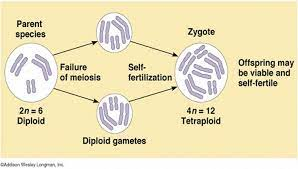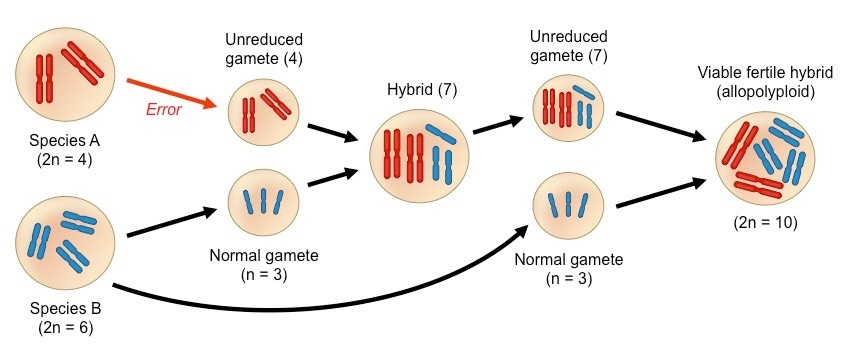BIOL 152 Exam #2 - Chapters 24,25: Speciation and Phylogenies
1/68
There's no tags or description
Looks like no tags are added yet.
Name | Mastery | Learn | Test | Matching | Spaced |
|---|
No study sessions yet.
69 Terms
speciation
the evolution of two or more distinct species from a single ancestral species, resulting from a two-step process involving genetic isolation and genetic divergence
genetic isolation
occurs when some sort of barrier to gene flow isolates two populations within a species
genetic divergence
when mutation, natural selection, and genetic drift occur in each of the isolated populations during speciation
species
an evolutionarily independent population or group of populations
biological species concept
the definition of a species is such that species can interbreed in nature to produce viable fertile offspring among themselves but not with other species (reproductive isolation)
prezygotic isolation
prevents individuals from differing species from mating successfully
postzygotic isolation
when the hybrid offspring of mating between members of different species cannot survive or reproduce
cannot be evaluated in fossils
cannot be evaluated in species with asexual forms of reproduction
difficult to apply in populations without geographical overlap
more difficult than other methods and takes a lot of time
disadvantages of the biospecies concept (3 points)
morphospecies concept
wherein researchers identify evolutionarily independent lineages by differences in morphology, as distinguishing features are most likely to arise if populations are independent/isolated from gene flow
polymorphic species
a species with 2 or more distinct phenotypes in the same breeding population at the same time
cryptic species
a species which cannot be distinguished from a similar species through easily identifiable morphological traits
more subjective than other methods
cannot identify cryptic species
may lead to the naming of many more species than what actually exist
disadvantages of the morphological species concept (3 points)
phylogenetic species concept
where species are classified as the smallest monophyletic group in a phylogenetic tree
monophyletic group
an evolutionary unit that includes an ancestral population and all of its descendants, but no others
synapomorphy
a characteristic present in an ancestral species and shared exclusively (in more or less modified form) by its evolutionary descendants.
allows for recognition of phylogenetic groups
monophyletic groups are assumed to be nested within one another
carefully estimated phylogenies are available for only a tiny subset of populations on the tree of life
tends to recognize more species than the other two concepts (some think this is more representative of the diversity of life on earth, however).
disadvantages of the phylogenetic species concept (2 points)
systematics
discipline of biology that characterizes and classifies the relationships of all organisms
taxonomy
the practice of describing/naming/classifying species
allopatry
condition in which 2+ populations live in different geographic areas
allopatric speciation
speciation occurring when populations of the same species become geographically isolated, often due to dispersal or vicariance
biogeography
study of how species and populations are distributed geographically
allopatric speciation by dispersal
migration of a population from one habitat to another and experiencing selection that causes speciationa
allopatric speciation by vicariance
where continental drift, climate fluctuations, etc. fuel speciation by splitting a population and allowing selection act separately on each part
reinforcement
natural selection for traits that prevent interbreeding for recently diverged species (prevents hybridization; AKA disruptive selection)
sympatry
when populations of species live in the same geographic area, close enough to breed/interbreed
sympatric speciation
speciation that occurs even through living in the same geographic area, affected by both extrinsic and intrinsic factors
niche
the range of ecological resources that a species can use and the range of conditions it can tolerate. sort of like an ecological “role”
polyploidy
the condition of possession two or more sets of complete chromosomes, caused by massive error in mitosis or meiosis
autopolyploid
individuals are produced when a mutation results in a doubling of chromosomes and the chromosomes are all from the same species
duplication of the SAME genome (diploid parents, tetraploid offspring)

allopolyploid
individuals created when parents of different species mate and an error in mitosis occurs, resulting in viable non sterile offspring with 2 full sets of chromosomes
combination of 2 genomes from differing species
common in plants
increases genetic variation and heterozygosity

hybrid zone
geographic area where interbreeding occurs between species, sometimes producing fertile hybrid offspring
phylogeny
branching evolutionary history of species/other groups of organisms
phylogenetic tree
simplified diagram of evolutionary history
tree of life
universal phylogenetic tree
taxa
any named group of organisms at any level of a classification system
sister groups
two lineages that are each other’s closest relatives, represented by two branches emerging from a node in a phylogenetic tree
character
any heritable genetic, morphological, physiological, developmental, or behavioral characteristic of an organism to be studied (AKA trait)
outgroup
a taxon that is not part of the taxonomic group studied but is closely related; added to establish the direction of change for each character
ancestral trait
a trait found in the ancestors of a particular group
derived trait
a trait that is a modified form of an ancestral trait, found in a descendant
assumes homology (assumes derived character states evolve only once, and that if two organisms share a trait, they must be evolved from a common ancestor, which happens but is not always true)
assumes reversals in a character state doesn’t occur, which creates the appearance that no change occurred.
issues with Henig’s method (2 points)
homoplasy
similarity among organisms of different species due to reasons other than common ancestry (like convergent evolution)
parsimony
the principle that the most likely explanation of a phenomenon is the most economical/simplest. For phylogenetic trees, this means that the most likely is the one requiring the fewest character changes.
bioinformatics
a discipline at the intersection of biology, compsci, and statistics concerned with the storage, analysis, and presentation of biological data
convergent evolution
common cause of homoplasy; the independent evolution of similar traits in different organisms due to similar habitats/lifestyles
paleontologist
scientist who studies the fossil record/history of life
fossils
any physical trace of an organism that existed in the past. Includes tracks, burrows, bones, casts, and so on
intact fossil
forms when decomposition does not occur/the organic remains are preserved intact
compression fossil
forms when sediments accumulate on top of an organism and become cemented into rocks
cast fossil
forms when a buried organism decomposes, leaving an empty cavity in the sediments that fills with dissolved minerals and hardens into an accurate cast of the remains
permineralized fossil
forms when organisms decompose extremely slowly and dissolved minerals gradually infiltrate the interior of cells/harden into stone
trace fossil
forms when sedimentation and mineralization preserve indirect evidence of an organism in the environment, including footprints, tracks, burrows, feeding marks, and feces
habitat bias
organisms living in environments where sediment is actively deposited are more likely to form (beaches/wetlads/mudflats)
taxonomic and tissue bias
where organisms with hard parts like bones/shells are more likely to fossilize because of their slower rates of decomposition
temporal bias
wherein recent fossils are much more common because the older a fossil is, the longer it has been exposed to potentially destructive forces in deep layers of rock
abundance bias
when the fossil record is weighted toward common species, as abundant organisms are much more likely to leave more traces than others
precambrian
interval between the formation of earth and the appearance of animals
mostly unicellular organisms (like, exclusively)
divided into Hadean, Archaean, and Protozoan eons
oxygen was virtually absent from the oceans and atmosphere. eventually, cyanobacteria released enough O2 to change this
phanerozoic eon
interval between 541 million years ago and the present. divided into 3 eras:
paleozoic era - appearance of most major animal lineages/ends with obliteration of almost all unicellular life
mesozoic era - ends with extinction of dinosaurs (except birds) and other groups. Gymnosperms are dominant plants, dinosaurs are dominant animal.
cenozoic era - angiosperms are dominant plants, birds and mammals are dominant vertebrates
anthropocene
proposed new, current epoch in the geologic time scale to reflect the dramatic physical, chemical, and biological changes that humans are causing on earth
adaptive radiation
rapid evolutionary diversification in one lineage, producing many descendant species that have adapted to a wide variety of habitats
ecological opportunity - there are many vacant niches in a given environment and few competitors
innovation - new morphological, physiological, or behavioral traits that allow for new habitat colonization, new food sources, etc. that may trigger adaptive radiation
reasons/conditions for adaptive radiation (2 points)
ecomorphs
groups of organisms that have similar behavioral/physical traits and are adapted to specific ecological niches
cambrian explosion
rapid diversification of animal body types/lineages occuring in a 50 million year period
documented by fossil assemblages with distinctive fauna
fauna
all the animal species characteristic of a particular region/period/environment
in the cambrian period - sponges, jellies, comb jellies, mollusks, echinoderms, etc.
mass extinction
rapid extinction of a large number of diverse species around the world (specifically when 60%+ of species are wiped out within 1 million years)
background extinction
the lower, average rate of extinction observed when a mass extinction is not occurring
occurs with normal environmental change, disease, predation pressure, or when competition reduces populations to zero
end-permian extinction
“Mother of mass extinctions” wherein flood basalts belched heat, CO2, and SO2 into the atmosphere. Resulted in:
severe acid rain
widespread coal fires pumping toxic ash into atmosphere
severe depletion of O2 in the atmosphere
dramatic reduction in sea level
End-cretaceous extinction
mass extinction event involving the impact hypothesis stating that a collision between earth and asteroid caused the mass extinction ending the cretaceous period.
fireball of hot gas spreading from impact site let to massive wildfires
largest tsunami in the last 3.5 billion years disrupted ocean sediments/circulation patterns
sulfate-containing rock disrupted which reacted w/ water to form acid rain
sun was blocked by large quantities of dust and ash, causing a crash in plant productivity
sixth mass extinction
extinction due to human impacts (habitat loss, pollution, overexploitation, climate change, invasive species, etc.)